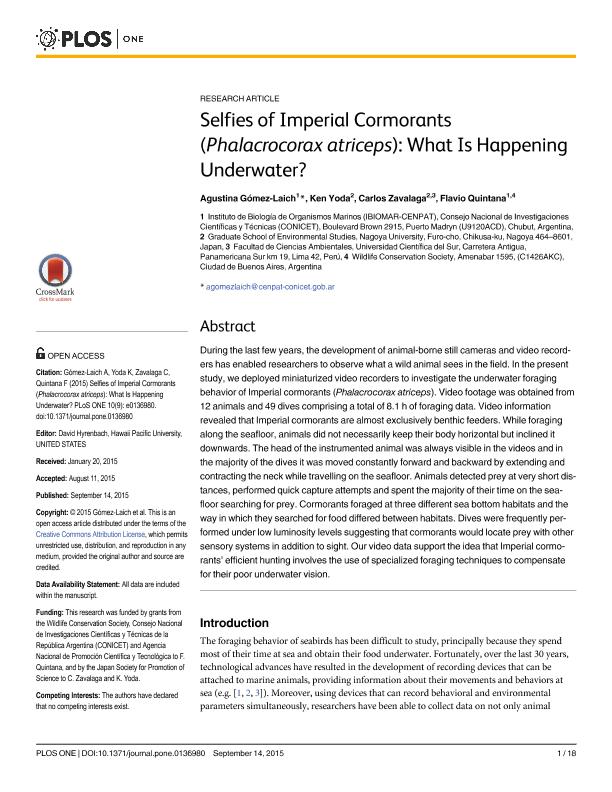Mostrar el registro sencillo del ítem
dc.contributor.author
Gómez Laich, Agustina Marta

dc.contributor.author
Yoda, Ken
dc.contributor.author
Zavalaga, Carlos
dc.contributor.author
Quintana, Flavio Roberto

dc.date.available
2018-02-26T19:26:51Z
dc.date.issued
2015-09
dc.identifier.citation
Gómez Laich, Agustina Marta; Yoda, Ken; Zavalaga, Carlos; Quintana, Flavio Roberto; Selfies of imperial cormorants (Phalacrocorax atriceps): What is happening underwater?; Public Library of Science; Plos One; 10; 9; 9-2015; 1-18; e0136980
dc.identifier.issn
1932-6203
dc.identifier.uri
http://hdl.handle.net/11336/37148
dc.description.abstract
During the last few years, the development of animal-borne still cameras and video recorders has enabled researchers to observe what a wild animal sees in the field. In the present study, we deployed miniaturized video recorders to investigate the underwater foraging behavior of Imperial cormorants (Phalacrocorax atriceps). Video footage was obtained from 12 animals and 49 dives comprising a total of 8.1 h of foraging data. Video information revealed that Imperial cormorants are almost exclusively benthic feeders. While foraging along the seafloor, animals did not necessarily keep their body horizontal but inclined it downwards. The head of the instrumented animal was always visible in the videos and in the majority of the dives it was moved constantly forward and backward by extending and contracting the neck while travelling on the seafloor. Animals detected prey at very short distances, performed quick capture attempts and spent the majority of their time on the seafloor searching for prey. Cormorants foraged at three different sea bottom habitats and the way in which they searched for food differed between habitats. Dives were frequently performed under low luminosity levels suggesting that cormorants would locate prey with other sensory systems in addition to sight. Our video data support the idea that Imperial cormorants' efficient hunting involves the use of specialized foraging techniques to compensate for their poor underwater vision.
dc.format
application/pdf
dc.language.iso
eng
dc.publisher
Public Library of Science

dc.rights
info:eu-repo/semantics/openAccess
dc.rights.uri
https://creativecommons.org/licenses/by-nc-sa/2.5/ar/
dc.subject
Imperial Cormoran
dc.subject
Video Cameras
dc.subject
Underwater Foraging Behaviour
dc.subject.classification
Otras Ciencias Biológicas

dc.subject.classification
Ciencias Biológicas

dc.subject.classification
CIENCIAS NATURALES Y EXACTAS

dc.title
Selfies of imperial cormorants (Phalacrocorax atriceps): What is happening underwater?
dc.type
info:eu-repo/semantics/article
dc.type
info:ar-repo/semantics/artículo
dc.type
info:eu-repo/semantics/publishedVersion
dc.date.updated
2018-02-22T14:28:08Z
dc.journal.volume
10
dc.journal.number
9
dc.journal.pagination
1-18; e0136980
dc.journal.pais
Estados Unidos

dc.journal.ciudad
San Francisco
dc.description.fil
Fil: Gómez Laich, Agustina Marta. Consejo Nacional de Investigaciones Científicas y Técnicas. Centro Científico Tecnológico Conicet - Centro Nacional Patagónico. Instituto de Biología de Organismos Marinos; Argentina
dc.description.fil
Fil: Yoda, Ken. Nagoya University; Japón
dc.description.fil
Fil: Zavalaga, Carlos. Universidad Científica del Sur; Perú. Nagoya University; Japón
dc.description.fil
Fil: Quintana, Flavio Roberto. Consejo Nacional de Investigaciones Científicas y Técnicas. Centro Científico Tecnológico Conicet - Centro Nacional Patagónico. Instituto de Biología de Organismos Marinos; Argentina. Wildlife Conservation Society; Estados Unidos
dc.journal.title
Plos One

dc.relation.alternativeid
info:eu-repo/semantics/altIdentifier/url/http://journals.plos.org/plosone/article?id=10.1371/journal.pone.0136980
dc.relation.alternativeid
info:eu-repo/semantics/altIdentifier/doi/http://dx.doi.org/10.1371/journal.pone.0136980
Archivos asociados
